Diving ducks are fun to watch but can be difficult to identify as they spend a lot of time submerged. One of the most striking is Common Goldeneye, a rare breeding bird in Britain, but a widespread and familiar winter visitor. A favourite among the diving ducks, it is usually found on inland waterbodies, as well as sheltered coastal areas. It can be easily distinguished from most other species, but two vagrants from North America provide interesting identification challenges.
Barrow's Goldeneye is closely related and looks similar, and Bufflehead, while in the same genus, Bucephala, is a little more distinctive. The identity of these two species will rarely be in question, but there are individuals (particularly females and immatures) which defy positive identification, as well as interesting problems involving birds that may be hybrids between Common and Barrow's. Also, with any unusual wildfowl species, there is always the problem of determining whether any bird is truly wild or simply an escape.
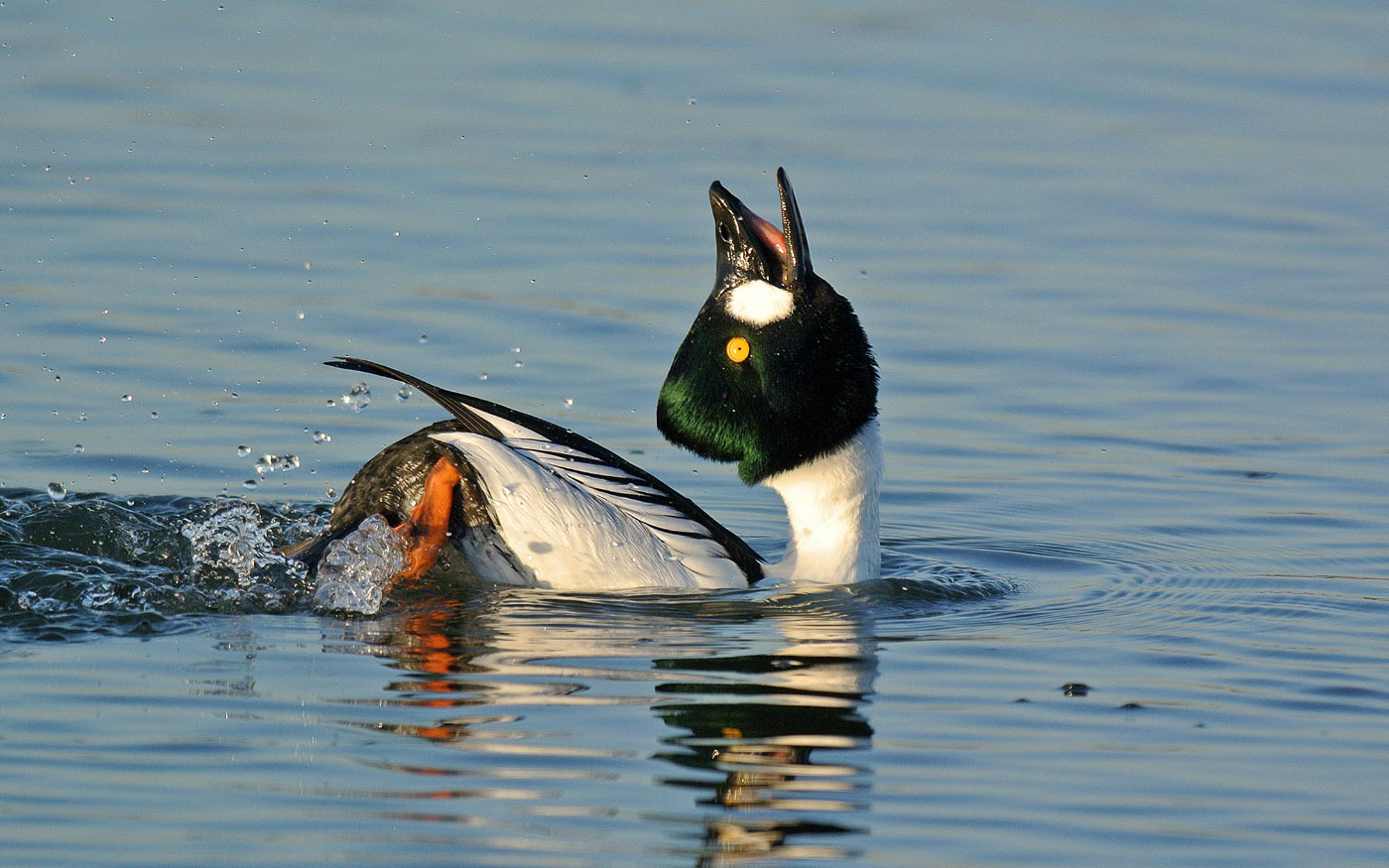
Adult male Common Goldeneye (Seaforth, Lancashire, 14 January 2012). This drake Common Goldeneye is unmistakable as it displays to a female. The male's courtship begins in winter and involves throwing its head back and pointing the bill skywards, while calling and kicking its feet up out of the water. The green sheen on the dark, peaked head and the almost circular white loral patch in front of the bright yellow eye are characteristic of this species. Note the long white scapular feathers with thin black edges, draping down in a line above the flanks, separating the intense black back from the brilliant white underparts (Steve Young / www.birdsonfilm.com).
Common Goldeneye
This species breeds across northern Europe, Asia and North America and winters to the south. It is a rare breeding bird in Britain, with 100-200 females, mainly in Scotland. In winter about 20,000 individuals arrive and are fairly widespread, with concentrations in estuaries like the Forth and Humber, as well as on inland waters such as Abberton Reservoir, Essex, and Rutland Water, Rutland. There are two subspecies, with the North American form americana being slightly larger than the Eurasian clangula, and having a larger bill.
The adult male has striking black-and-white plumage. Its large black head has a green gloss and a white loral spot which appears egg shaped or circular. The neck, breast and underparts are bright white, the back is black, and the white scapulars are broken by lines of black.
First-winter males look more like females, with a browner head, and some may have an indistinct crescent-shaped loral spot for a short time, looking similar in plumage to Barrow's Goldeneye; however, this spot always reaches below the eye.
Head shape is critical when trying to distinguish between the goldeneyes. Imagine a line along the lower edge of the bill and another along the front of the forehead. In Barrow's these are virtually at right angles, while in Common they are at more of an acute angle, giving it a 'peaked' look. The eyes of adult males are a bright yellow, while females are pale yellow to white.
Barrow's Goldeneye
Barrow's breeds mainly in north-western North America, wintering along the Pacific coast and also inland. Small numbers breed in eastern Canada and Greenland, wintering along the east coast of North America, while a mainly resident population nests in Iceland. It is monotypic.
There have been four accepted UK records. The first was in Ayrshire in November-December 1979, with the next in Aberdeenshire in May-June 2005. An individual was present from November-April in 2005-06, 2006-07 and 2007-08 in Co Down, and the fourth was in Perthshire from November 2006 to April 2007.
The exact origin of birds recorded in Britain and Ireland is unclear; as all accepted reports have been adult males, it may be that females and immatures are being overlooked. As a sociable species, any vagrant is quite likely to associate with Common Goldeneyes and would appear slightly larger.
Adult male Barrow's Goldeneye is distinctive. Its black head has a blue-green sheen and there is a large crescent-shaped white patch in front of the eye which extends above it. Its back is black and the white scapulars are broken by neat rows of large black patches. A black spur extends down the side of the white breast from the front of the wing. First-winter males will have a browner head.
The female has a darker brown head than Common, with a rounded crown (not peaked), and a shorter but stouter bill, sometimes being largely orange. In flight, the wing contains less white on the secondaries and coverts than Common. Bill colour is useful when trying to separate female Common from Barrow's Goldeneye, but first-winter females of both species may have dark bills at the start of the winter.
The eyes of adult males are a bright yellow, while females are dark yellow, not as pale as Common Goldeneye. Although difficult to see in the field, the nostrils differ in shape and can be seen right through in Barrow's but not in Common.
Bufflehead
The small and distinctive Bufflehead breeds in Alaska and eastwards across most of Canada, wintering down to the south of North America. The adult male is strikingly obvious, with a black, green and purple glossed 'puffy' head with a large white patch extending back from the eye and around the neck, a black back and white underparts.
The female is largely brownish, with a darker head and a clear white auricular patch extending back from behind and below the eye. In flight the female shows less white on the inner secondaries. Although the same genus as the goldeneyes, Bufflehead is notably different in having dark brown irises when adult.
There have been 17 accepted occurrences in Britain up to 2014, mostly in the period October to April. Five were in Scotland and 12 in England, the most recent being in October 2014 on Orkney. Ireland has had just two accepted records. Most have involved adult males.
Bufflehead is popular in captivity and colour-ringed birds are occasionally seen, presumably all escapes. The second half of October and November is the classic period for Nearctic wildfowl to appear in Britain and any seemingly wild unringed bird appearing at this time is more likely to be genuine.
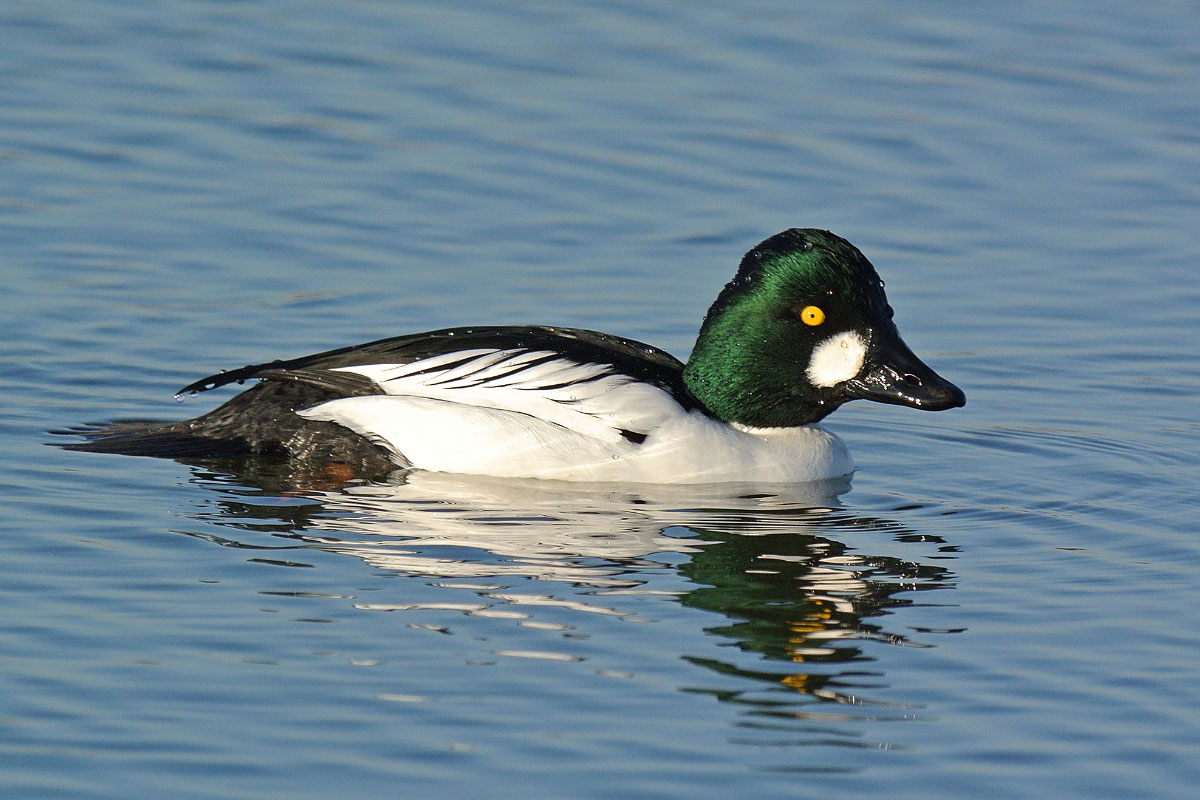
Adult male Common Goldeneye (Seaforth, Lancashire, 14 January 2012). This Common Goldeneye has just surfaced from a dive, with gleaming water droplets on its back. Its most conspicuous defining feature is the white oval on the face, in front of and below the eye. The dark head shines green in good light, but otherwise appears black. The neck, breast, underparts and flanks are white, while the back, primaries, tail and undertail are black. Note the pattern of the scapulars: white with thin black streaks across them. Look at the black beak and imagine a line along the bottom of the bill, and another along the forehead – the two meet at a reasonably sharp angle (Steve Young / www.birdsonfilm.com).

Adult male Barrow's Goldeneye (Lake Mývatn, Iceland, 8 June 2016). On drake Barrow's Goldeneye, the white loral patch is crescent shaped and extends to just above the eye. The dark head has a blue-green sheen and is less peaked, more rounded, than that of Common. The body is similar to Common Goldeneye, but the broader black edgings to the white scapulars make a more patched appearance, and the black upperparts extend further forward onto the breast, with more black on the upper flanks. The bill is shorter and stouter; again, imagine lines along its base and along the forehead, which meet almost at right angles. If you look closely, you can see through the nostrils, unlike in Common Goldeneye (Conor Molloy).
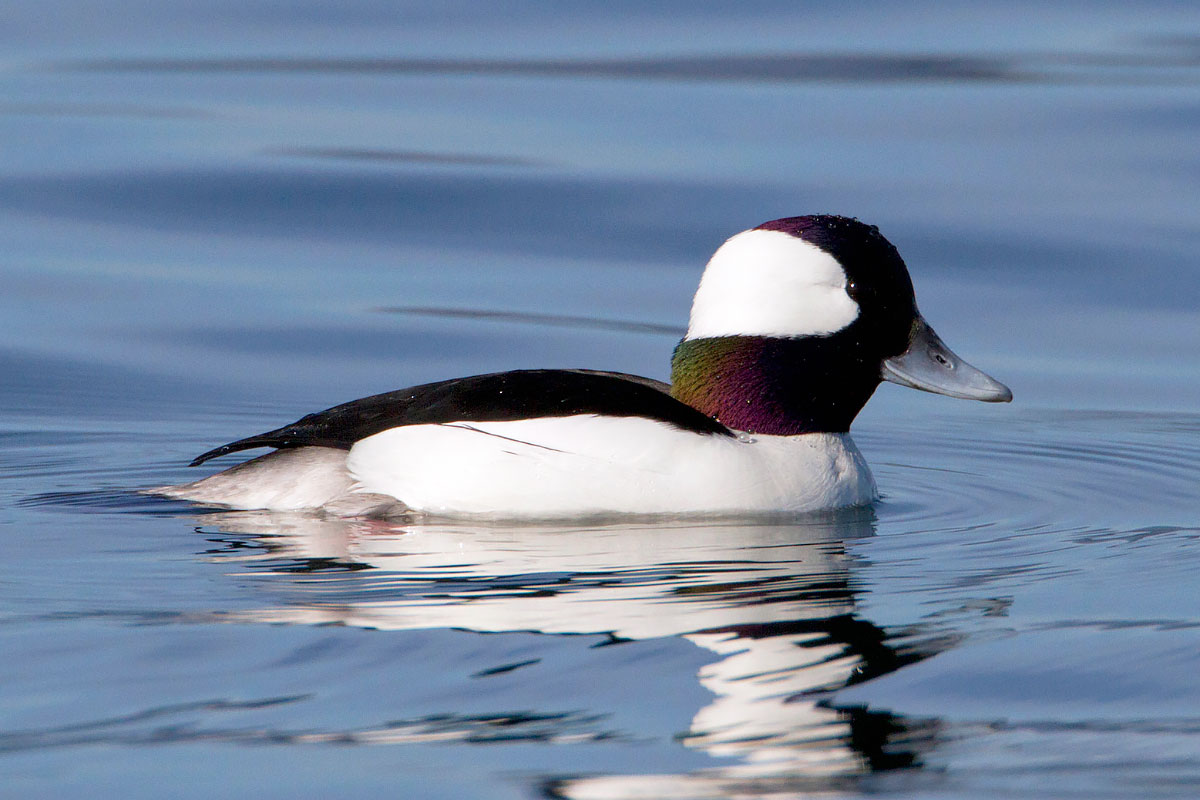
Adult male Bufflehead (British Columbia, Canada, 3 March 2015). Bufflehead is named for its large, rounded head, and the head pattern of the drake is unlike any other duck. Its huge, white auricular patch extends back from the eye, wrapping around the back of its contrasting black head, which has a purple-green sheen. Unlike its relatives, the goldeneyes, it has a dark eye and the bill is blue-grey. It has a black back and rump, with grey tail coverts and tail. Its neck, breast and belly are white and it has pure white scapulars. It is smaller than the goldeneyes and also a frequent diver (Martin Smart).

Adult female Common Goldeneye (Seaforth, Lancashire, 28 January 2009). The rich, chocolate-brown head of female Common Goldeneye has a distinctive 'peaked' shape, almost triangular, and ends abruptly on a white neck. Its underparts are greyish and birds on the water usually show some of the white from their wings and wing coverts, which looks like a broken white line above the flanks. The eye is almost white and the beak is black with a yellow tip, but some birds have all-black bills or pinkish tips and others (probably immatures) occasionally having most of the bill yellowish (Steve Young / www.birdsonfilm.com).
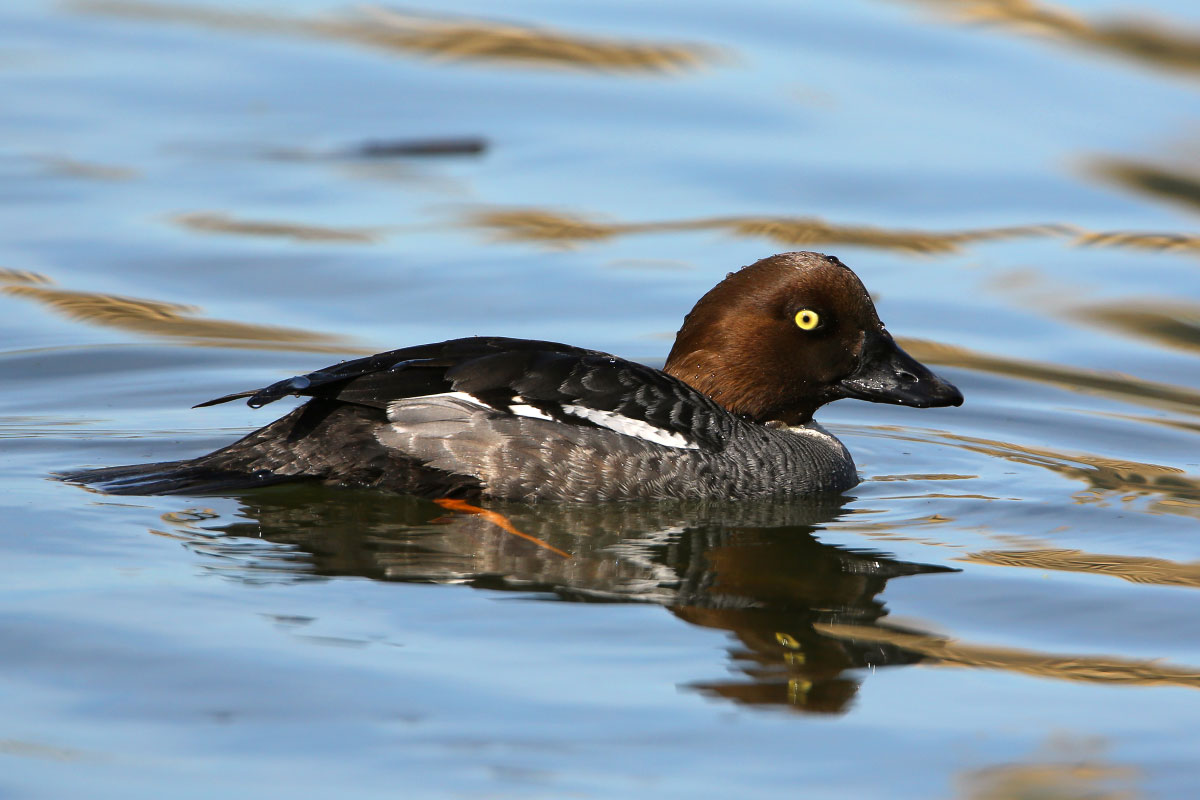
Adult female Common Goldeneye (California, USA, 5 February 2016). This female has just surfaced from a dive and the head does not appear markedly peaked, but imagining a line along the angle of the forehead and another along the lower line of the bill base still holds good, as it makes a sharp angle. The bill looks long, almost as long as the head, which is longer than Barrow's. The flank line, greyish flanks and darker back are the same in both goldeneyes. This individual has a pale yellow eye and is the americana form, having a larger bill than the Eurasian subspecies in photo 5 (Aurélien Audevard).

Adult female Barrow's Goldeneye (British Columbia, Canada, 19 May 2011). This bird shows the typical brown head and yellow eye of a goldeneye, but the brown almost forms a 'mane' on the back of the neck. The bill on this bird is mostly orange which suggests Barrow's Goldeneye; the clinching feature is the head shape, which is clearly rounded. The forehead is steep, and drawing imaginary lines produces a virtual right angle. Some female Barrow's Goldeneyes from North America can have a bill which is mostly bright orange, which Icelandic birds and Common Goldeneyes do not show. Icelandic birds have an orangish-tipped bill with a dark base (Glenn Bartley / www.agami.nl).

Adult female Bufflehead (California, USA, 12 December 2012). As small as a Black-necked Grebe, this tiny duck is distinctive, with its large dark brown head and oval-shaped white patch below and behind the eye. It may show a small white patch on the closed wing but often doesn't. Its eye is dark, its beak is grey and, if seen, its feet are also grey. Young males look similar to females before they moult into adult plumage (Brian E Small / www.agami.nl).

First-winter male Common Goldeneye (Seaforth, Lancashire, 3 February 2007). Young male Common Goldeneyes look very like females and as they gradually attain the plumage features of an adult they can look a little puzzling. This bird does not have a full white face patch yet and looks similar to Barrow's Goldeneye of the same age. However, note the 'peaked' head with a sloping forehead. Look closely at the white patch which is slightly below the bottom of the beak – it would not reach down so far in Barrow's. Eclipse males can look similar to this (Steve Young / www.birdsonfilm.com).

First-winter male Barrow's Goldeneye (California, USA, 3 February 2008). Looking quite like a female, this young male Barrow's Goldeneye still has a dark brown head, but it has already attained its crescent-shaped white face patch, which reaches higher than in Common Goldeneye and only goes down to the base of the bill. Note the rounded, almost flat-headed profile and stouter beak when compared to Common Goldeneye in photo 9. Eclipse males can look similar to this (Mike Danzenbaker / www.agami.nl).

First-winter male Bufflehead (California, USA, 1 February 2016). This bird is starting to attain the features of an adult male. Its beak is blue-grey, its underparts are becoming last through the bird's first winter and into its second summer. The underparts become fully white, the back black and the auricular patch covers the neck by its second winter (Aurélien Audevard).
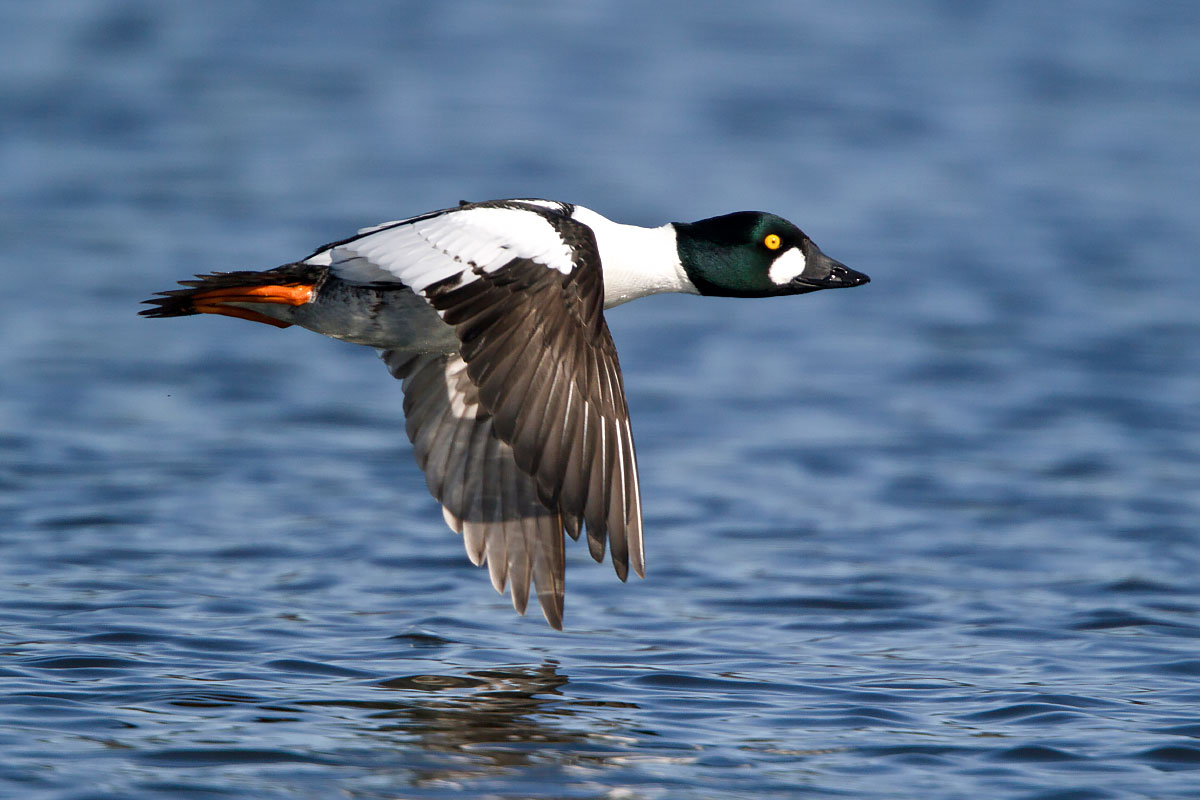
Adult male Common Goldeneye (British Columbia, Canada, 3 March 2011). In flight Common Goldeneye appears quite short necked and the drake has fast, whistling wing-beats. A large amount of white can be seen in the wings, as seven or eight secondaries and the greater and median coverts all appear bright white, forming an unbroken panel. The wing coverts actually have dark bases which are usually not visible. If seen, the scapulars usually appear as a solid white lines along the black back (Glenn Bartley / www.agami.nl).
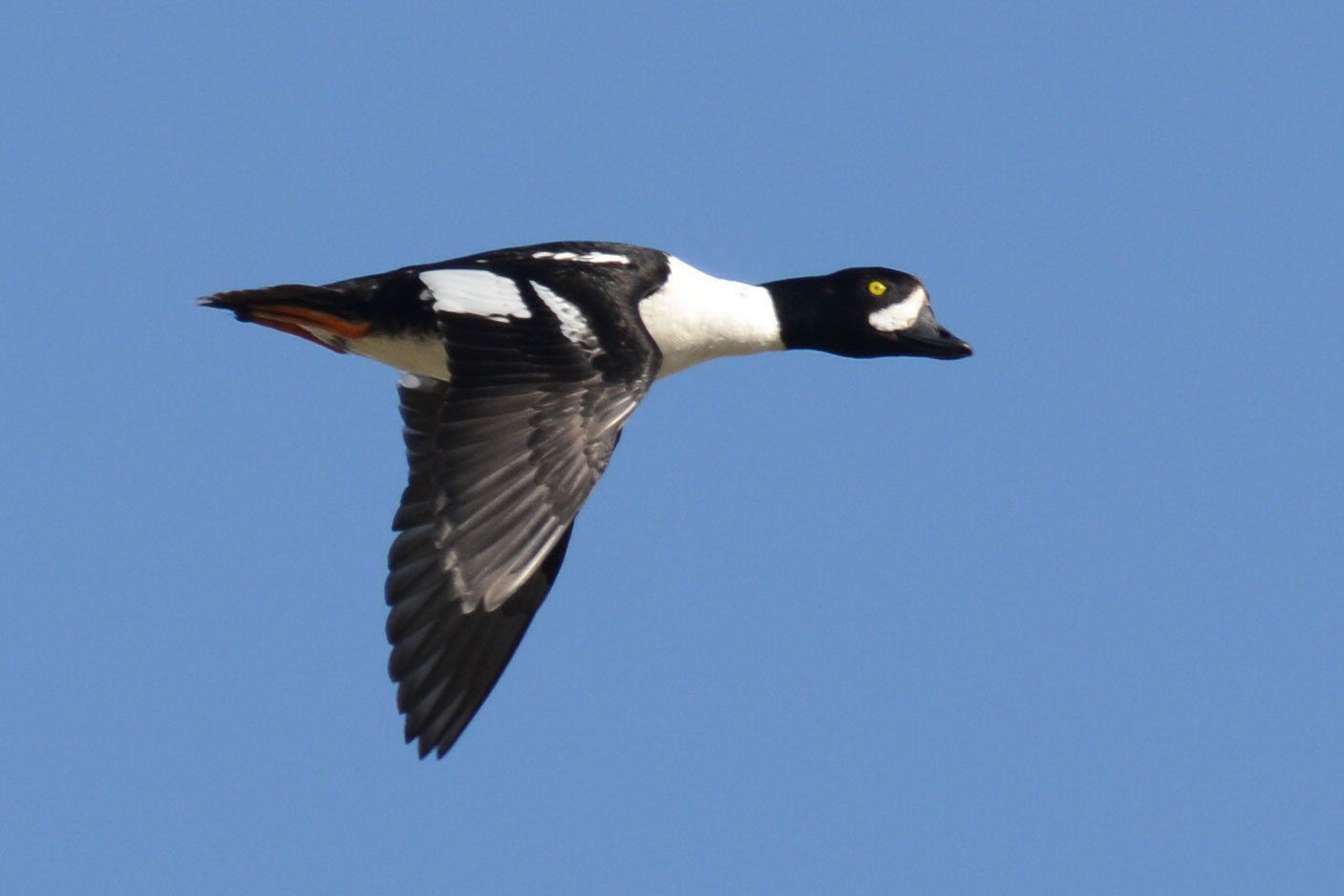
Adult male Barrow's Goldeneye (Lake Mývatn, Iceland, 18 June 2012). In flight Barrow's Goldeneye has similar fast wing-beats and whistling wings to Common. This bird clearly shows much less white on the wing than drakes of that species. Six or so of the secondaries are white and the bases of the greater and median coverts are black, forming two different white patches separated by a black band. This means the patch is narrower and does not extend so far to the front of the wing. If seen, the scapulars may appear as a broken white line (Laurens Steijn / www.agami.nl).

Adult male Bufflehead (British Columbia, Canada, 28 February 2009). At first glance a male Bufflehead in flight resembles a small, fast Common Goldeneye, but with silent wings. It has a similar wing pattern, with a narrow white patch formed by six secondaries and their associated coverts, with the median coverts also being all white. The white of the neck and upper back joins white of the scapulars to form a distinct pattern with the rest of the black back. The uppertail coverts are grey (Glenn Bartley / www.agami.nl).

Adult female Common Goldeneye (Seaforth, Lancashire, 4 November 2006). A good view of the wings of a female Common Goldeneye in flight can help with its identification. Seven or more secondaries and their associated coverts are largely white. The greater secondary coverts have black tips which form a bar between these coverts and the secondaries, with the median coverts also having black tips separating them from the greater coverts with a second bar. This wide white area, broken by the two black bars, is seldom found in Barrow's. Wings of immatures (both males and females) are similar to this (Steve Young / www.birdsonfilm.com).
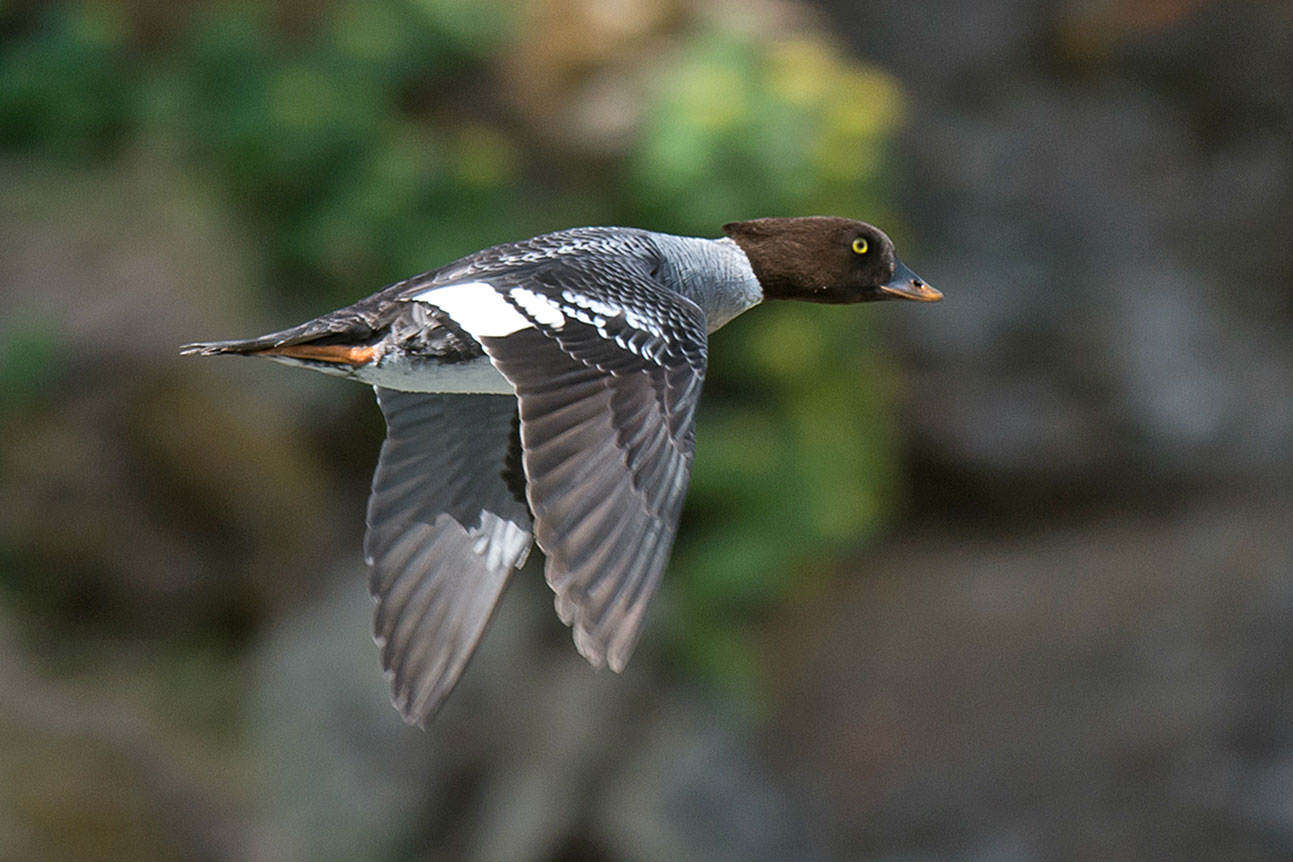
Adult female Barrow's Goldeneye (Lake Mývatn, Iceland, 13 June 2012). Fewer than seven secondaries are white in female Barrow's Goldeneye, making the white wing patch noticeably narrower than in Common. The white greater coverts have black bases and tips, and the median coverts can be black with white tips or mostly white, and extending out further across the wing forming an indistinct white-and-black patch. This creates a narrower white area broken by one or two black bars. Wings of immatures (both males and females) are similar to this (Steve Young / www.birdsonfilm.com).

Female Bufflehead (British Columbia, Canada, 3 March 2011). A female Bufflehead can look a little like a small female Common Goldeneye, as its pale auricular patch may not be so obvious in flight. However, the wing pattern is very different as it shows white on six of the inner secondaries and often none on the secondary coverts, which are brown, although there is sometimes a small white line on the greater coverts. This results in a much reduced white wing patch. The body is dull brown with white central underparts and the head noticeably dark (Glenn Bartley / www.agami.nl).
- This article was originally published in the January 2019 issue of Birdwatch magazine.





